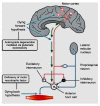The Dying Forward Hypothesis of ALS: Tracing Its History
- PMID: 33673524
- PMCID: PMC7997258
- DOI: 10.3390/brainsci11030300
The Dying Forward Hypothesis of ALS: Tracing Its History
Abstract
The site of origin of amyotrophic lateral sclerosis (ALS), although unsettled, is increasingly recognized as being cortico-fugal, which is a dying-forward process primarily starting in the corticomotoneuronal system. A variety of iterations of this concept date back to over 150 years. Recently, the hallmark TAR DNA-binding protein 43 (TDP-43) pathology, seen in >95% of patients with ALS, has been shown to be largely restricted to corticofugal projecting neurons ("dying forward"). Possibly, soluble but toxic cytoplasmic TDP-43 could enter the axoplasm of Betz cells, subsequently causing dysregulation of nuclear protein in the lower brainstem and spinal cord anterior horn cells. As the disease progresses, cortical involvement in ALS becomes widespread, including or starting with frontotemporal dementia, implying a broader view of ALS as a brain disease. The onset at the motor and premotor cortices should be considered a nidus at the edge of multiple cortical networks which eventually become disrupted, causing failure of a widespread cortical connectome.
Keywords: TDP-43; amyotrophic lateral sclerosis; dying-forward; frontotemporal dementia; neural networks; neurodegeneration.
Conflict of interest statement
The author declares no conflict of interest.
Figures

Similar articles
-
Pathological TDP-43 changes in Betz cells differ from those in bulbar and spinal α-motoneurons in sporadic amyotrophic lateral sclerosis.Acta Neuropathol. 2017 Jan;133(1):79-90. doi: 10.1007/s00401-016-1633-2. Epub 2016 Oct 18. Acta Neuropathol. 2017. PMID: 27757524 Free PMC article.
-
Cortical influences drive amyotrophic lateral sclerosis.J Neurol Neurosurg Psychiatry. 2017 Nov;88(11):917-924. doi: 10.1136/jnnp-2017-315573. Epub 2017 Jul 14. J Neurol Neurosurg Psychiatry. 2017. PMID: 28710326 Review.
-
Amyotrophic lateral sclerosis represents corticomotoneuronal system failure.Muscle Nerve. 2025 Apr;71(4):499-511. doi: 10.1002/mus.28290. Epub 2024 Nov 7. Muscle Nerve. 2025. PMID: 39511939 Free PMC article. Review.
-
An autopsy case of early-stage amyotrophic lateral sclerosis with TDP-43 immunoreactive neuronal, but not glial, inclusions.Neuropathology. 2019 Jun;39(3):224-230. doi: 10.1111/neup.12554. Epub 2019 Apr 24. Neuropathology. 2019. PMID: 31020724
-
Lower motor neuron involvement in TAR DNA-binding protein of 43 kDa-related frontotemporal lobar degeneration and amyotrophic lateral sclerosis.JAMA Neurol. 2014 Feb;71(2):172-9. doi: 10.1001/jamaneurol.2013.5489. JAMA Neurol. 2014. PMID: 24378564
Cited by
-
Axon Biology in ALS: Mechanisms of Axon Degeneration and Prospects for Therapy.Neurotherapeutics. 2022 Jul;19(4):1133-1144. doi: 10.1007/s13311-022-01297-6. Epub 2022 Oct 7. Neurotherapeutics. 2022. PMID: 36207571 Free PMC article. Review.
-
Adaptive Remodeling of the Neuromuscular Junction with Aging.Cells. 2022 Mar 29;11(7):1150. doi: 10.3390/cells11071150. Cells. 2022. PMID: 35406714 Free PMC article. Review.
-
Differential Epigenetic Signature of Corticospinal Motor Neurons in ALS.Brain Sci. 2021 Jun 7;11(6):754. doi: 10.3390/brainsci11060754. Brain Sci. 2021. PMID: 34200232 Free PMC article.
-
Breached Barriers: A Scoping Review of Blood-Central Nervous System Barrier Pathology in Amyotrophic Lateral Sclerosis.Front Cell Neurosci. 2022 Mar 31;16:851563. doi: 10.3389/fncel.2022.851563. eCollection 2022. Front Cell Neurosci. 2022. PMID: 35431812 Free PMC article.
-
Mitochondrial Dyshomeostasis as an Early Hallmark and a Therapeutic Target in Amyotrophic Lateral Sclerosis.Int J Mol Sci. 2023 Nov 27;24(23):16833. doi: 10.3390/ijms242316833. Int J Mol Sci. 2023. PMID: 38069154 Free PMC article. Review.
References
-
- Snowden J.S., Harris J., Richardson A., Rollinson S., Thompson J.C., Neary D., Mann D.M., Pickering-Brown S. Frontotemporal dementia with amyotrophic lateral sclerosis: A clinical comparison of patients with and without repeat expansions in C9orf72. Amyotroph. Lateral Scler. Front. Degener. 2013;14:172–176. doi: 10.3109/21678421.2013.765485. - DOI - PubMed
Publication types
LinkOut - more resources
Full Text Sources
Other Literature Sources
Research Materials
Miscellaneous

